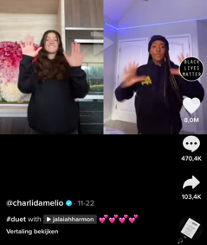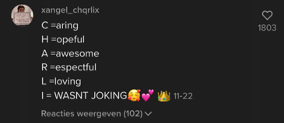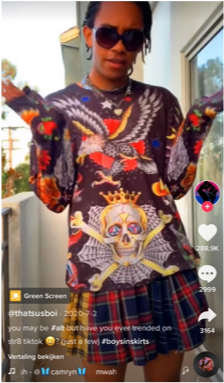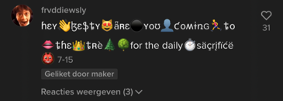
Straight TikTok versus Alt TikTok: the creation of deviance from within
On TikTok, many users are currently divided into two groups: Straight TikTok and Alt TikTok. Recently these two dominant social groups have been taking over the platform, each with their own trends, language, and norms. This had led to a peculiar feud, with users from both Straight and Alt TikTok creating deviance and exclusion on the app. This article aims to explain TikTok, its social groups, and the feud that has emerged between these communities.
What is TikTok?
Compared to other social media platforms, TikTok can be considered somewhat of an outsider. Whereas on Instagram or Facebook, users are encouraged to post whatever they want in terms of pictures, text, or videos, TikTok users are restricted to only posting videos. Additionally, the ‘following' page is not as popular on TikTok as it is on apps like Instagram. Most TikTok users only visit the For You Page (FYP) to watch videos and see their follower page as an additional feature.
On the FYP, users come across short videos that are scored with ‘sounds’. These sound clips are an important part of TikTok's culture, as the sound used gives creators an indication of how well their video will do. Using snippets of popular songs can help creators draw attention to their TikToks. Creators can also create their own sound by simply recording themselves. These sounds can go viral as well, as lip-syncing is an important part of the app’s culture.
The FYP is entirely based on the user’s interests, which is why TikTok is constantly rising in popularity. This rising popularity has led to the creation of two camps with opposing interests: Straight and Alt TikTok.
Straight TikTok
When TikTok users are on Straight TikTok, they get to see dances, POVs, and people with a lot of influence on the app. Straight TikTokkers, such as Tony Lopez, Bryce Hall, Addison Rae or Charli Damelio, are generally more popular than Alt TikTokkers, as they are part of the mainstream in the context of TikTok. Almost everyone likes to see pretty people dance or lip-sync to a song. This is why Straight TikTokkers are sometimes considered micro-celebrities: Charli Damelio already has over a 100 million followers, even though she only started a little over a year ago.
Popular Straight TikTokkers, therefore, are verified most of the time, whereas most popular Alt TikTokkers are not. An important thing to note is that Straight TikTokkers are not necessarily straight. The name attributed to this community has nothing to do with sexuality.

Figure 1. Charli Damelio doing the ‘Renegade’ with its creator Jalaiah Harmon.
To be a part of a social group, as Howard Becker describes in Outsiders (1963), one has to master the norms, language, and emblems of the group. Just like every other social group, Straight TikTok has norms in place.
Dancing is important. To be an influential Straight TikTokker, one has to dance to trending sounds. Most of the time, dance choreographies are created by less popular TikTokkers. Popular Straight TikTokkers recreate these dances and are supposed to give credit to the original creators. These dances, such as the ‘Renegade’ dance or the ‘Savage’ dance, can then go viral on Straight TikTok. When this happens, amateur creators from all over the world recreate the dance.
To be part of the Straight TikTok community, creators and users alike have to know what sounds or dances are popular at a particular time. Figure 1 shows that Charli Damelio got over eight million likes for doing the Renegade dance with its original creator, which shows how important these dances are. However, as Becker describes in Outsiders (1963), there is inequality in power, as popular Straight TikTokkers can decide which sounds or dances becp,e well-known. Popular creators like Charli Damelio thus enforce the norms on Straight TikTok.

Figure 2. A comment on Damelio’s video, showing that this user is a fan of Charli Damelio.
A second feature of Straight TikTokkers is being somewhat conventionally attractive, as Straight TikToks only consist of relatively simple dance moves, boys staring dreamingly into the camera or point-of-view roleplays. This can be seen as superficial. Straight TikTokkers do not need to be academically intelligent; they are not popular because they bring awareness to societal issues. They just need to look good in front of the camera.
To be part of the community, users need to know a lot about these pretty and popular creators. Users should know where they live, who their friends are and if they are in a relationship. As most popular Straight TikTokkers are also considered micro-celebrities, users almost have to consider themselves a fan of these creators to be part of the community. Figure 2 shows how intrigued users can be by their favorite creators. @xangel_chqrlix obviously really likes Charli Damelio and seems to be a fan of hers, making them part of the Straight TikTok community.
Alt TikTok
On Alt TikTok, users get to see everything that is not considered mainstream: e-girls and e-boys, artistic talent, boys wearing make-up, anime content, and queer relationships. Because of this quite literally alternative content, Alt TikTokkers usually do not have as many followers as Straight TikTokkers. A large part of Alt TikTok focuses on mocking and making fun of Straight TikTok, as these users feel like the mainstream sometimes needs to be called out. The Alt side is considered to be the funny side of TikTok; humor is important for these users. Popular Alt TikTokkers are @goodvibetris, Chris Sutherland and @spencewuah.

Figure 3. A comment on Miller’s dance video, claiming he is a better dancer than Charli Damelio. This is meant as a joke.
Just like Straight TikTok, Alt TikTokkers have to take some norms into account. Alt TikTok content cannot resemble Straight TikTok content. Simple dances, POVs or ‘thirst traps' are not tolerated by the community, unless there is humor involved. For this reason, it happens quite often that Alt TikTokkers sarcastically react to Straight TikTok. For example, Noah Miller, a popular Alt TikTokker, has posted a TikTok of himself sarcastically doing a simple dance to make fun of Straight TikTok. The comments under his video are mostly sarcastic as well, as his followers know he is trying to be funny. An example can be found above (see Figure 3).

Figure 4. A video of Alt user @thatsusboi, who likes wearing skirts.
In general, content thus has to be funny. However, Alt content can also bring awareness to certain social issues or discuss behaviors that are not accepted by the mainstream, such as boys wearing dresses or e-girls' clothing habits. Figure 4 shows a video of Alt user @thatsusboi, who enjoys wearing skirts and encourages his followers to be unapologetically themselves. The comments indicate how supportive his fellow Alt users are, as compliments like ‘king’ and ‘the fits went hard’ were commented numerous times. However, the video also appeared on Straight TikTok. A comment resulting from this will be discussed in a subsequent section.

Figure 5. A comment with the phrase ‘are you coming to the tree’, which got posted on a lot of videos.
Language use is also important. On Alt TikTok, just like on Straight TikTok, trends appear. These trends often have to do with a certain phrase or saying. Often times, videos with catchy, funny or relatable phrases go viral on Alt TikTok. When this happens, Alt users comment the phrases on totally unrelated videos, for which they receive a lot of likes from their fellow Alt users. A phrase recently popular in the community is ‘are you coming to the tree’, as seen in the example above (Figure 5).
An Alt user reacted to this comment by saying: ''WHY ARE WE LIKE THIS OMG.'' This indicates this user feels like they are a part of the social group. They identify with an Alt TikTok comment and assume others will too. Other phrases that have gone viral are ‘I ain’t never seen two pretty best friends’ and ‘calm down Jamal, don’t pull out the nine’. This all shows how important language use is for the community.
The feud
As shown above, Straight and Alt TikTok can almost be considered opposites, as their norms, trends, and language differ tremendously. This has led to a feud, with both groups making fun of each other, excluding each other, and creating deviance.
According to Howard Becker (1963), deviance is a social construct. A person who does not obey certain group rules is labeled as an outsider by others. This, of course, is not a new phenomenon, various social groups have been labeled as deviant throughout history, such as LGBTQ+ people, punks, e-girls, and boys in skirts. These groups do not meet the mainstream criteria of normality and are excluded from social settings. It is therefore no surprise that "alternative" or "deviant" people have come together on Alt TikTok. Here, they do not have to obey mainstream societal expectations; they can be completely themselves.
With this comes the rejection of mainstream ideals. Deviance now goes the other way around, as Alt TikTokkers want to stay as far away as possible from the Straight side of TikTok. Consequently, a reoccurring discourse around Straight TikTok has to do with deviance. Alt TikTokkers often label Straight TikTok as boring, flavorless, or even scary. To analyze this discourse, we will look at the three practices proposed by Charles Goodwin in Professional Vision (1994): coding, highlighting and the producing of material representations.

Figure 6. A comment on a video of @thatsusboi wearing a skirt.

Figure 7. A comment posted on a video that shows three alternative girls in punk clothes, highlighting that Straight TikTok is not openminded.
For Alt TikTok users, acceptance of diversity is very important. Seeing a boy in a skirt is, therefore, normal to them. Straight TikTok users, on the other hand, ‘just don’t appreciate’ boys in skirts, as shown by Figure 6. The Alt commenter explicitly refers to Straight TikTok users as ‘they’, which indicates an us-versus-them mentality. With this, they highlight that Alt TikTok users are far more accepting than Straight TikTok users. For this reason, Alt TikTokkers do everything in their power to not be associated with the ‘the other side’. With this, they create deviance.
Through this discourse on the 'other', Alt TikTokkers define group relations. As Blommaert & Verschueren argue in Debating Diversity (1998), group relations and group identities are cognitively framed phenomena found at the inter-subjective level of the community. The idea that Straight TikTok users are not openminded is shared by the majority of the Alt TikTok community. Another example highlighting this is shown by Figure 7:

Figure 8. A comment posted on a Straight TikTok, indicating they are proud to be part of Alt TikTok.
Thus, Alt TikTok users want to distance themselves from the mainstream ideals accepted by Straight TikTok. To do this, they code certain behavior as ‘Straight TikTok behavior’ and label this as deviant, calling it boring, scary, or weird. Sometimes, they label Straight TikTok users ‘normies’, as shown in Figure 8. The term ‘normie’ can be considered as a derogatory term to describe the mainstream, meaning this commenter takes pride in not being a part of Straight TikTok. With this, they define Straight TikTok as deviant.

Figure 9. A comment indicating Straight TikTok is sickening.
Another comment (see Figure 9) posted on this same Straight TikTok shows how Straight TikTok even makes them sick; this user "gags" every time they see a Straight TikTok and "marks it as not interested." TikTok allows users to give feedback on videos shown on their FYP, marking a post as "not interested" will filter similar posts out of future videos shown to that user. This shows that the user does not want anything to do with the mainstream, as it is gross. With this, they create deviance. Other users replied to this comment by saying that Straight TikTok is ‘horrifying’ and ‘scary’.

Figure 10. A comment on a Straight TikTok, indicating Straight TikTok is weird.
On another Straight TikTok, an Alt TikTok user commented that ‘Straight TikTok is weird’, and received over 93.000 likes (Figure 10). The video in question shows an attractive boy staring into the camera and lip-syncing to a trending song with his shirt off. Something that is seen as normal by the mainstream gets turned around by alternative users, who highlight it as weird and therefore deviant behavior. The TikTok video, in that sense, can be seen as a material representation, as it complements and strengthens the commenter’s argument. Users might indeed label Straight TikTok as weird when they watch the video that goes with the comment. This behavior thus gets coded as 'Straight TikTok behavior' and therefore deviant.

Figure 11. A comment indicating Straight TikTok users are the weird ones now.
As alternative people have always been rejected by the mainstream, Alt TikTok users feel it is now their turn to make fun of the mainstream. This is shown in Figure 11. Whereas alternative people used to be called weird, now it is Straight TikTok users. The comment shows that this user is happy with the development; Straight TikTok users finally get to experience what it feels like to be an outsider. Additionally, The Alt commenter uses the words ‘they’ and ‘our’ to indicate that TikTok is indeed divided into two groups, and that they are proud to be part of the alternative side.
However, Alt TikTok users are not the only ones creating deviance. Straight TikTok users, too, describe the ‘other side’ as weird, and they describe their own side as ‘normal’. Unlike the creation of deviance on Alt TikTok, deviance is not as clear on the Straight side of TikTok. This is because Straight TikTokkers often do not even know there is a Straight and Alt side. The name ‘Straight TikTok’ has been ascribed by Alt TikTok users. However, some mainstream users have found a way to get a grip on the meanings of Straight and Alt TikTok, and label Alt TikTok as deviant.

Figure 12. A comment highlighting that Straight TikTok is the ‘normal’ TikTok.
The comment above (Figure 12) was posted on the same comment shown by Figure 7. This Straight commenter defines Straight TikTok as ‘normal’ TikTok, indicating he codes Alt TikTok as abnormal. This is where mainstream ideals come into play. For many people, it is ‘normal’ to be straight. It is ‘normal’ to dress the way everyone else dresses and it is ‘normal’ to behave the way everyone else behaves. When this idea of normality is violated, the mainstream labels the perpetrator an outsider.
Alt TikTok, in this sense, does not meet the mainstream’s criteria for normality. The mainstream often feels like their ideas about the world are natural. However, normality is a social construct; social groups themselves define group relations, which has a lot to do with power. The mainstream still has the power to define LGBTQ+ people, punks or boys in dresses as deviant, as they are minorities. Alt TikTok, is, therefore, defined as deviant and abnormal by some Straight TikTok users.
The mainstream has always labeled behavior that does not meet their criteria of normality as deviant. They did not need to create a specific TikTok social group to keep doing this. However, alternative users felt the need to create their own social group on TikTok, in order to ridicule and call out the mainstream. With this, they have created a feeling of belonging and acceptance for Alt TikTok users, while also labeling Straight TikTok as deviant.
Final thoughts
TikTok, with its rising popularity, has paved the way for the creation of two new social groups: Alt and Straight TikTok. As these groups have different norms, trends and language, they also have their own normality. Through these ideas about normality they define group relations and create deviance. Alt TikTok users feel like they can reject mainstream ideals on their side of the app. They have created a social group on TikTok where they can be completely themselves, while also making fun of the ‘normies’.
However, mainstream users who have discovered Alt TikTok sometimes also create deviance. The mainstream still has the power to define alternative people as outsiders. Even though Straight TikTok users often do not know they are part of the social group, they clearly have ideas about what is normal and what is abnormal.
Deviance is thus created from within the app, and users from both sides take part in it, as they both have their own ideas about normality. Further research into how TikTok’s deviance is constructed could definitely lead to interesting new insights.
References
Becker, H. (1963). Outsiders: Studies in the sociology of deviance. The Free Press.
Blommaert, J., & Verschueren, J. (1998). Debating diversity: Analysing the discourse of tolerance. Routledge.
Goodwin, C. (1994). Professional vision. American Anthropologist, 606-633.